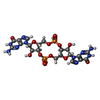+ Open data
Open data
- Basic information
Basic information
| Entry | Database: PDB / ID: 9lmq | ||||||
|---|---|---|---|---|---|---|---|
| Title | Cryo-EM structure of TIR-STING/c-di-GMP complex | ||||||
 Components Components | CD-NTase-associated protein 12 | ||||||
 Keywords Keywords | HYDROLASE / NADase | ||||||
| Function / homology |  Function and homology information Function and homology informationNAD+ glycohydrolase / NADP+ nucleosidase activity / defense response to virus / nucleotide binding Similarity search - Function | ||||||
| Biological species |  Epilithonimonas lactis (bacteria) Epilithonimonas lactis (bacteria) | ||||||
| Method | ELECTRON MICROSCOPY / single particle reconstruction / cryo EM / Resolution: 2.88 Å | ||||||
 Authors Authors | Lu, D.F. / Liu, S. | ||||||
| Funding support |  China, 1items China, 1items
| ||||||
 Citation Citation |  Journal: mBio / Year: 2025 Journal: mBio / Year: 2025Title: Structural insights into distinct filamentation states reveal a regulatory mechanism for bacterial STING activation. Authors: Yuchao Yang / Yueyue Liu / Xue Ma / Xuan Zhao / Jian Cao / Yu Liu / Shanqin Li / Jing Wu / Yuanzhu Gao / Lianwan Chen / Changxin Wu / Guijun Shang / Sheng Liu / Defen Lu /  Abstract: The cyclic oligonucleotide-based antiphage signaling system (CBASS) is a bacterial immune mechanism that was evolutionarily linked to the eukaryotic cGAS-STING pathway, which protects against phage ...The cyclic oligonucleotide-based antiphage signaling system (CBASS) is a bacterial immune mechanism that was evolutionarily linked to the eukaryotic cGAS-STING pathway, which protects against phage infection through abortive cell death. CBASS operons encode cyclic dinucleotide synthases (CD-NTases) and effector proteins (Caps), such as bacterial STING, which senses cyclic dinucleotides like 3'3'-c-di-GMP to trigger defense. Although bacterial STING oligomerizes into filaments upon ligand binding, the functional roles of distinct filament states remain unclear. Here, we resolve cryo-EM structures of TIR-STING (STING) bound to 3'3'-c-di-GMP, revealing two oligomeric states: spiral-shaped single filaments and fiber bundles composed of straight protofibrils. In spiral filaments, the STING domain sequesters the TIR domain's BB loop within a hydrophobic core, suppressing NADase activity. This inactive conformation is stabilized by interactions between the CBDα4 helix and the TIR domain, as well as a calcium-binding site. Conversely, fiber bundle formation-driven by inter-protofibril TIR domain interactions-disrupts these autoinhibitory contacts, liberating the BB loop to enable head-to-tail assembly of adjacent TIR domains into a composite NADase-active site. Calcium ions promote spiral filament assembly while inhibiting fiber bundles, revealing a dual regulatory role in tuning STING activation. Strikingly, this mechanism diverges from single-filament systems like STING, underscoring evolutionary diversity in STING signaling. Our findings establish distinct filament architectures as structural checkpoints governing bacterial STING activation, providing mechanistic insights into how conformational plasticity and environmental cues like calcium regulate abortive infection. These results highlight parallels between prokaryotic and eukaryotic immune strategies, emphasizing conserved principles in pathogen defense across domains of life.IMPORTANCEBacteria employ a sophisticated immune system, CBASS, evolutionarily related to human antiviral pathways, to defend against viral (phage) attacks. This study reveals how the bacterial protein STING acts as a molecular switch, transitioning between an inactive spiral structure stabilized by calcium ions and an active fiber bundle. When calcium levels drop, STING reorganizes into fiber bundles, activating its ability to degrade essential cellular molecules. This self-destructive mechanism halts phage replication by sacrificing the infected cell, protecting the bacterial population. The findings demonstrate how structural rearrangements govern life-or-death immune decisions, mirroring principles in human STING signaling. By uncovering calcium's role in regulating this process, the work deepens our understanding of microbial immunity and highlights shared strategies across domains of life. These insights could inspire novel antimicrobial therapies or bioengineered systems to combat infections, bridging fundamental science with practical applications in health and biotechnology. | ||||||
| History |
|
- Structure visualization
Structure visualization
| Structure viewer | Molecule:  Molmil Molmil Jmol/JSmol Jmol/JSmol |
|---|
- Downloads & links
Downloads & links
- Download
Download
| PDBx/mmCIF format |  9lmq.cif.gz 9lmq.cif.gz | 432.5 KB | Display |  PDBx/mmCIF format PDBx/mmCIF format |
|---|---|---|---|---|
| PDB format |  pdb9lmq.ent.gz pdb9lmq.ent.gz | 360.6 KB | Display |  PDB format PDB format |
| PDBx/mmJSON format |  9lmq.json.gz 9lmq.json.gz | Tree view |  PDBx/mmJSON format PDBx/mmJSON format | |
| Others |  Other downloads Other downloads |
-Validation report
| Summary document |  9lmq_validation.pdf.gz 9lmq_validation.pdf.gz | 1.5 MB | Display |  wwPDB validaton report wwPDB validaton report |
|---|---|---|---|---|
| Full document |  9lmq_full_validation.pdf.gz 9lmq_full_validation.pdf.gz | 1.5 MB | Display | |
| Data in XML |  9lmq_validation.xml.gz 9lmq_validation.xml.gz | 74.5 KB | Display | |
| Data in CIF |  9lmq_validation.cif.gz 9lmq_validation.cif.gz | 110.7 KB | Display | |
| Arichive directory |  https://data.pdbj.org/pub/pdb/validation_reports/lm/9lmq https://data.pdbj.org/pub/pdb/validation_reports/lm/9lmq ftp://data.pdbj.org/pub/pdb/validation_reports/lm/9lmq ftp://data.pdbj.org/pub/pdb/validation_reports/lm/9lmq | HTTPS FTP |
-Related structure data
| Related structure data |  63221MC  9lmrC M: map data used to model this data C: citing same article ( |
|---|---|
| Similar structure data | Similarity search - Function & homology  F&H Search F&H Search |
- Links
Links
- Assembly
Assembly
| Deposited unit | 
|
|---|---|
| 1 |
|
- Components
Components
| #1: Protein | Mass: 35717.707 Da / Num. of mol.: 8 Source method: isolated from a genetically manipulated source Source: (gene. exp.)  Epilithonimonas lactis (bacteria) / Gene: IO89_10965 / Production host: Epilithonimonas lactis (bacteria) / Gene: IO89_10965 / Production host:  #2: Chemical | ChemComp-C2E / #3: Chemical | ChemComp-CA / #4: Water | ChemComp-HOH / | Has ligand of interest | Y | Has protein modification | N | |
|---|
-Experimental details
-Experiment
| Experiment | Method: ELECTRON MICROSCOPY |
|---|---|
| EM experiment | Aggregation state: PARTICLE / 3D reconstruction method: single particle reconstruction |
- Sample preparation
Sample preparation
| Component | Name: TIR-STING/c-di-GMP complex / Type: COMPLEX / Entity ID: #1 / Source: RECOMBINANT |
|---|---|
| Source (natural) | Organism:  Epilithonimonas lactis (bacteria) Epilithonimonas lactis (bacteria) |
| Source (recombinant) | Organism:  |
| Buffer solution | pH: 8 |
| Specimen | Embedding applied: NO / Shadowing applied: NO / Staining applied: NO / Vitrification applied: YES |
| Vitrification | Cryogen name: ETHANE |
- Electron microscopy imaging
Electron microscopy imaging
| Experimental equipment |  Model: Titan Krios / Image courtesy: FEI Company |
|---|---|
| Microscopy | Model: TFS KRIOS |
| Electron gun | Electron source:  FIELD EMISSION GUN / Accelerating voltage: 300 kV / Illumination mode: FLOOD BEAM FIELD EMISSION GUN / Accelerating voltage: 300 kV / Illumination mode: FLOOD BEAM |
| Electron lens | Mode: BRIGHT FIELD / Nominal defocus max: 2000 nm / Nominal defocus min: 1000 nm |
| Image recording | Electron dose: 50 e/Å2 / Film or detector model: GATAN K2 QUANTUM (4k x 4k) |
- Processing
Processing
| EM software | Name: PHENIX / Version: 1.19.2_4158 / Category: model refinement | ||||||||||||||||||||||||
|---|---|---|---|---|---|---|---|---|---|---|---|---|---|---|---|---|---|---|---|---|---|---|---|---|---|
| CTF correction | Type: PHASE FLIPPING AND AMPLITUDE CORRECTION | ||||||||||||||||||||||||
| 3D reconstruction | Resolution: 2.88 Å / Resolution method: FSC 0.143 CUT-OFF / Num. of particles: 523122 / Symmetry type: POINT | ||||||||||||||||||||||||
| Refinement | Highest resolution: 2.88 Å Stereochemistry target values: REAL-SPACE (WEIGHTED MAP SUM AT ATOM CENTERS) | ||||||||||||||||||||||||
| Refine LS restraints |
|
 Movie
Movie Controller
Controller




 PDBj
PDBj





